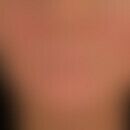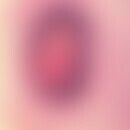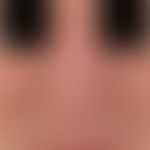Synonym(s)
DefinitionThis section has been translated automatically.
Disturbance in the shape of the nose due to diffuse or circumscribed sebaceous gland hyperplasia with gradually increasing, localized or diffuse, shapeless, fleshy bulging of the nose. Mostly partial symptom of rosacea (stage III of rosacea - glandular hyperplastic rosacea)
Clinically, a distinction is made for differential diagnostic reasons
- the (more frequent) diffuse rhinophyma and
- the (rarer) localized or circumscribed rhinophyma
EtiopathogenesisThis section has been translated automatically.
Rhinophyma is based on diffuse connective tissue hyperplasia with hyperplasia of the sebaceous follicles and vascular dilatation.
You might also be interested in
ManifestationThis section has been translated automatically.
Almost exclusively men in the 5th to 6th decade of life.
Clinical featuresThis section has been translated automatically.
Diffuse rhinophyma: Irregularly configured, painless, skin-coloured or yellow-red, misshapen bulges of the nose with deeply retracted, dilated follicles. This leads to grotesque outgrowths so that the original shape of the nose is no longer recognizable. The proliferated tissue feels soft and elastic. When pressure is applied, a white sebum secretion is released from the follicle openings.
Circumscribed rhinophyma: In this variant, a localised tumour-like nodulation occurs with an otherwise unchanged nose.
The differentiation between "diffuse and localized" is useful, because in the localized form other differential diagnostic considerations come into play.
Tumour-like phymogenesis is also found in other areas rich in sebaceous glands; see also otophym, metophym, gnathophym.
HistologyThis section has been translated automatically.
Differential diagnosisThis section has been translated automatically.
For diffuse rhinopyhm:
- Skin infiltrates in lymphatic leukemia and mycosis fungoides
For circumscribed localized rhinomphym:
- Basal cell carcinoma
- dermal melanocytic naeuvre
- fibrous nasal papilla
TherapyThis section has been translated automatically.
Stage-dependent therapy of rhinophyma:
- Stage I (edematous changes and sebaceous gland hyperplasia): Tetracycline or isotretinoin.
- Stage II (fibrosis and nodules): dermabrasion, laser therapy (CO2 laser). Pre- and postoperative tetracycline or isotretinoin.
- Stage III (coarse fibrosis, bulbous nodules, cysts and comedones): dermabrasion, laser therapy (CO2 laser), cryosurgery, electrocautery depending on the severity. Pre- and postoperative tetracycline or isotretinoin.
External therapyThis section has been translated automatically.
Internal therapyThis section has been translated automatically.
In stage 1 systemic therapy with tetracyclines (e.g. tetracycline Wolff Kps.) 3 times/day 500 mg. Alternatively: isotretinoin (e.g. acne normin) 0.1-0.5 mg/kg bw/day for sebaceous gland reduction. The pre- and post-operative administration of isotretinoin to reduce the operating field has also proven to be effective.
Operative therapieThis section has been translated automatically.
- From stage 2 on, surgical ablation of the hypertrophied tissue in LA or under general anaesthesia is recommended. The entire excess tissue is removed, leaving the deep sebaceous glands intact. Secondary wound treatment see below.
Remember! Therapy procedures with defined depth effect (e.g. dermabrasion) are preferable to less adjustable procedures (e.g. electrocautery, cryosurgery), as scarring is less frequent!
- In stage 2, dermabrasion or laser therapy(vaporization by CO2 laser) is particularly recommended. The advantage of laser procedures lies in the intra- and postoperative reduction of bleeding. With regard to healing time and scar formation, laser application probably shows no advantages over conventional methods.
- In stage 3, surgical ablation using a scalpel or focused CO2 laser is often unavoidable. Subsequent fine modulation with dermabrasion or defocused CO2 laser treatment improves the cosmetic results. All of the excess tissue is removed except for the cartilage, leaving the deep parts of the sebaceous glands intact. In secondary wound treatment, good granulation and re-epithelialisation usually takes place from here. Grafts and displacement plasty do not show good results. In "blind" procedures, a malignant event must be excluded beforehand.
Notice! Histological control of the ablated tissue! Malignant or semi-malignant tumours can (although very rarely) impress under the image of a rhinophyma!
Progression/forecastThis section has been translated automatically.
Rhinophyma, which has not been treated surgically, continues to develop. After surgical ablation there is rapid epithelialization, usually extensive, cosmetically acceptable scarring.
LiteratureThis section has been translated automatically.
- Blount BW et al (2002) Rosacea: a common, yet commonly overlooked, condition. On Fam Physician 66: 435-440
- Bogetti P et al (2002) Surgical treatment of rhinophyma: a comparison of techniques. Aesthetic Plast Surgery 26: 57-60
- Hae-El G et al (1993) The treatment of rhinophyma. 'Cold' vs. laser techniques. Arch Otolaryngol Head Neck Surg 119: 628-631
- Husein-ElAhmed H et al (2013) Management of severe rhinophyma with sculpting surgical decortication. Aesthetic Plast Surgery 37:572-575
- Kopera D (1992) CO2 laser treatment of a rhinophyma. dermatologist 43: 298-299
- Metternich FU et al (2003) Surgical treatment of rhinophyma with the ultrasonic scalpel (Ultracision Harmonic Scalpel). Laryngorhinootology 82: 132-137
- Petres J (1985) Therapy of Rhinophyma. dermatologist 36: 433-435
- Rebora A (2002) The management of rosacea. At J Clin Dermatol 3: 489-496
- Stucker FJ et al (2003) The AbCs of rhinophyma management. At J Rhinol 17: 45-49
- Tüzün Y etg al (2014) Rosacea and rhinophyma. Clin Dermatol 32:35-46
Incoming links (12)
Alcohol skin changes; Co2 laser; Dermabrasion; Gnathophyma; Metophyme; Nasal papilla fibrosus; Otophyma; Pound nose; Pug nose; Rhinophyma paraphrased; ... Show allOutgoing links (15)
Dermabrasion; Gnathophyma; Hyperplasia; Isotretinoin; Laser; Leukemia cutis; Local anesthesia; Metophyme; Mycosis fungoides; Otophyma; ... Show allDisclaimer
Please ask your physician for a reliable diagnosis. This website is only meant as a reference.


























